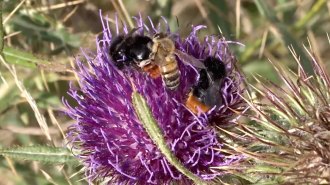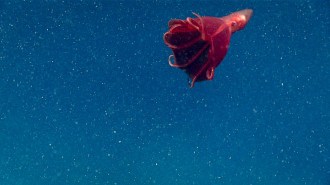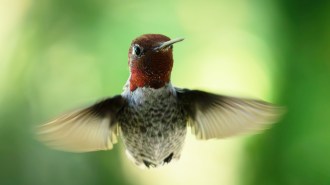Video
Sign up for our newsletter
We summarize the week's scientific breakthroughs every Thursday.
-
 Physics
PhysicsWhat happens when lawn sprinklers suck in water? Physicists answer that quirky question
Experiments with a floating sprinkler and laser-illuminated microparticles revealed the surprisingly complex physics behind a simple question.
-
 Life
LifeSome honeybees in Italy regularly steal pollen off the backs of bumblebees
New observations suggest that honeybees stealing pollen from bumblebees may be a crime of opportunity, though documentation of it remains rare.
-
 Climate
ClimateNumbats are built to hold heat, making climate change extra risky for the marsupials
New thermal imaging shows how fast numbats’ surface temperature rises even at relatively reasonable temperatures.
By Jake Buehler -
 Physics
PhysicsInvisible comet tails of mucus slow sinking flakes of ‘marine snow’
New measurements reveal the gunk that surrounds the particles, an important factor in understanding how the ocean sequesters carbon.
-
 Health & Medicine
Health & MedicineFlint grapples with the mental health fallout from the water disaster
The water crisis started almost a decade ago. Residents of Flint, Mich., are still healing from the disaster — and caring for their own.
-
 Animals
AnimalsHow hummingbirds fly through spaces too narrow for their wings
Using high-speed cameras, a new study reveals Anna’s hummingbirds turn sideways to shimmy through gaps half as wide as their wingspan.
-
 Animals
AnimalsFake fog, ‘re-skinning’ and ‘sea-weeding’ could help coral reefs survive
Coral reefs are in global peril, but scientists around the world are working hard to find ways to help them survive the Anthropocene.
-
 Planetary Science
Planetary ScienceIn a first, astronomers spot the afterglow of an exoplanet collision
A surge of infrared light from a remote star might have been a glow cast by the vaporized leftovers of an impact between Neptune-sized worlds.
By Elise Cutts -

Antimatter falls like matter, upholding Einstein’s theory of gravity
In a first, scientists dropped antihydrogen atoms and measured how they fell.
-
 Health & Medicine
Health & MedicineHow brain implants are treating depression
This six-part series follows people whose lives have been changed by an experimental treatment called deep brain stimulation.
-
 Neuroscience
NeuroscienceToday’s depression treatments don’t help everyone
In the second story in the series, deep brain stimulation is a last resort for some people with depression.
-
 Health & Medicine
Health & MedicineThere’s a stigma around brain implants and other depression treatments
The fifth article in the series asks why people are so uncomfortable with changing the brain.